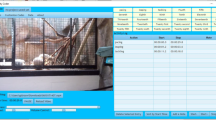Abstract
The use of computerized, digital video as a means for interactive data capture has been suggested as an alternative to direct observation of behavior. The appeal of observational measures is that they are presumed to be less vulnerable to potential biases from informants, such as parents or teachers, and permit more individualized assessment that may be lost with the use of rating scales. As a potential tool for long-term, automated observation and analysis. In this technology review we propose one promising model for the integration of computerized primitives recognition and annotated video patterns as an approach to large-scale autism diagnosis and research.






Similar content being viewed by others
References
National Institute of Child Health and Human Development (NICHD). (2005). Autism overview: What we know. Retrieved on April 5, 2007, from http://www.nichd.nih.gov/publications/pubs/upload/autism_overview_2005.pdf.
National Institute of Mental Health (NIMH). (2007). Autism spectrum disorders: Pervasive developmental disorders with addendum February 2007. Retrieved on April 4, 2007, from http://www.nimh.nih.gov/publicat/nimhautismspectrum.pdf.
Bell, R. Q., Structuring parent–child interaction situations for direct observation. Child Dev. 35:1009–1020, 1964.
Roberts, M. W., Clinic observations of structured parent–child interaction designed to evaluate externalizing disorders. Psychol. Assess. 13(1):46–58, 2001.
Campbell, S. B., Breaux, A. M., Ewing, L. J., and Szumowski, E. K., Correlates and predictors of hyperactivity and aggression: A longitudinal study of parent-referred problem preschoolers. J. Abnorm. Child Psychol. 14:217–234, 1986.
Campbell, S. B., Breaux, A. M., Ewing, L. J., Szumowski, E. K., and Pierce, E. W., Parent referred problem preschoolers: Mother child interaction during play at intake and one year. J. Abnorm. Child Psychol. 14:425–440, 1986.
Roberts, M. W., Joe, V. C., and Rowe-Hallbert, A., Oppositional child behavior and parental locus of control. J. Clin. Child Psychol. 21:170–177, 1992.
Webster-Stratton, C., Early intervention with videotape modeling: Programs for families of children with oppositional defiant disorder or conduct disorder. In: Hibbs, E. D., Jensen, P. S., (Eds.), Psychosocial treatments for child and adolescent disorders: Empirically based strategies for clinical practice pp. 435–474. Washington, DC: American Psychological Association, 1996.
Bahl, A. B., Spaulding, S. A., and McNeil, C. B., Treatment of noncompliance using parent child interaction therapy: A data-driven approach. Educ. Treat. Child. 22:146–156, 1999.
Barkley, R. A., and Cunningham, C. E., The effects of methylphenidate on the mother–child interactions of hyperactive children. Arch. Gen. Psychiatry. 36:201–208, 1979.
Patterson, G. R., Coercive family process. Eugene, OR: Castalia, 1982.
Wahler, R. G., Winkel, G. H., Peterson, R. F., and Morrison, D. C., Mothers as behavior therapists for their own children. Behav. Res. Ther. 3(2):113–124, 1965.
Wiltz, N. A., and Patterson, G. R., An evaluation of parent training procedures designed to alter inappropriate aggressive behavior of boys. Behav. Ther. 5:215–221, 1974.
Kazdin, A. E., Parent management training: Treatment for oppositional, aggressive, and antisocial behavior in children and adolescents. Oxford University Press: New York, 2005.
McMahon, R. J., and Forehand, R. L., Helping the noncompliant child: Family-based treatment for oppositional behavior. 2nd ed. New York: Guilford Press, 2003.
Robinson, E. A., and Eyberg, S. M., The dyadic parent–child interaction coding system: Standardization and validation. J. Consult. Clin. Psychol. 49:245–250, 1981.
Schuhmann, E. M., Foote, R. C., Eyberg, S. M., Boggs, S. R., and Algina, J., Efficacy of parent–child interaction therapy: Interim report of a randomized trial with short-term maintenance. J. Clin. Child Psychol. 27:34–45, 1998.
Webster-Stratton, C., and Hammond, M., Treating children with early-onset conduct problems: A comparison of child and parent training interventions. J. Consult. Clin. Psychol. 65:93–109, 1997.
Doussard-Roosevelt, J. A., Joe, C. M., Bazhenova, O. V., and Porges, S. W., Mother–child interaction in autistic and nonautistic children: Characteristics of maternal approach behaviors and child social responses. Dev. Psychopathol. 15:277–295, 2003.
Mahoney, G., and Perales, F., Relationship-focused early intervention with children with pervasive developmental disorders and other disabilities: A comparative study. Dev. Behav. Pediatr. 26:77–85, 2005.
Iwata, B. A., Dorsey, M. F., Slifer, K. J., Bauman, K. E., and Richman, G. S., Toward a functional analysis of self-injury. Anal. Intervent. Dev. Disabil. 2:3–20, 1982.
Koegel, R. L., Bimbela, A., and Schreibman, L., Collateral effects of parent training on family interactions. J. Autism Dev. Disord. 26:347–359, 1996.
Handen, B. L., Feldman, H. M., Lurier, A., and Murray, P. J. H., Efficacy of methylphenidate among preschool children with developmental disabilities and ADHD. J. Am. Acad. Child Adolesc. Psych. 38:805–812, 1999.
Kolmen, B. K., Feldman, H. M., Handen, B. L., and Janosky, J. E., Naltrexone in young autistic children: A double-blind, placebo-controlled crossover study. J. Am. Acad. Child Adolesc. Psych. 34:223–231, 1995.
Venetianer PL, Lipton AJ, Chosak AJ, Frazier MF, Haering N, Myers GW, Yin W, Zhang Z., Video surveillance system employing video primitives. United States Patent 7,868,912, January 11, 2011.
Tseng, S. M., Huang, J. H., Liuying Shiang, T. W., Su, J. H., and Qiaotou Shiang, T. W. Video annotation method by integrating visual features and frequent patterns. USPTO Application 20080059872, March 6, 2008. National Cheng Kung University, Tainan City, Taiwan.
Lipton, A., Heartwell, C., Haering, N., and Madden, D., Automated video protection, monitoring and detection, IEEE 731 Aerospace and Electronic Systems, 2003.
Niels Haering, N., and da Vitoria Lobo, N., Features and classification methods to annotate images with their deciduous tree content. Journal of Computer Vision and Image Understanding, 1999.
Author information
Authors and Affiliations
Corresponding author
Rights and permissions
About this article
Cite this article
Jameson, R., Lorence, D. & Lee, J. Integrating Computerized Primitives and Annotated Video Patterns: A Proposed Model for Autism Diagnosis and Research. J Med Syst 36, 2037–2045 (2012). https://doi.org/10.1007/s10916-011-9666-5
Received:
Accepted:
Published:
Issue Date:
DOI: https://doi.org/10.1007/s10916-011-9666-5




